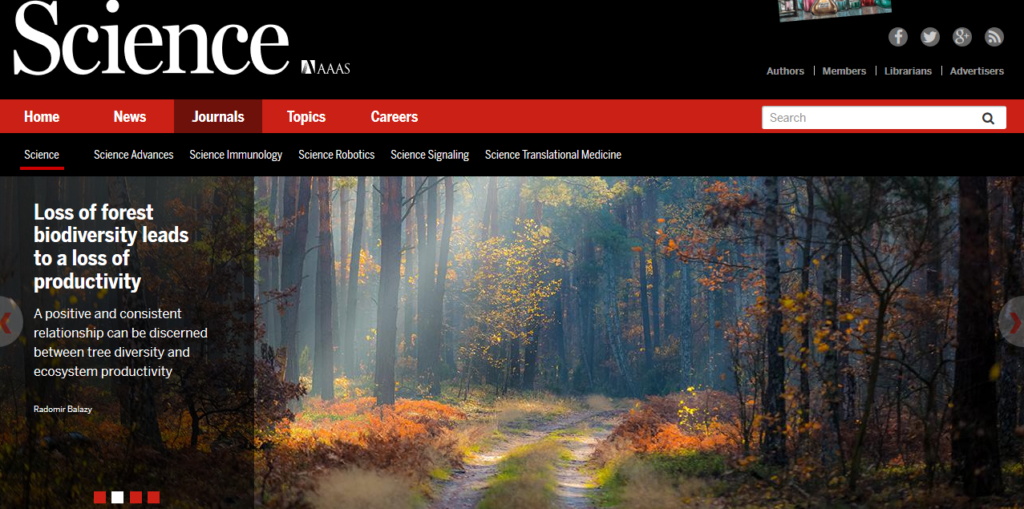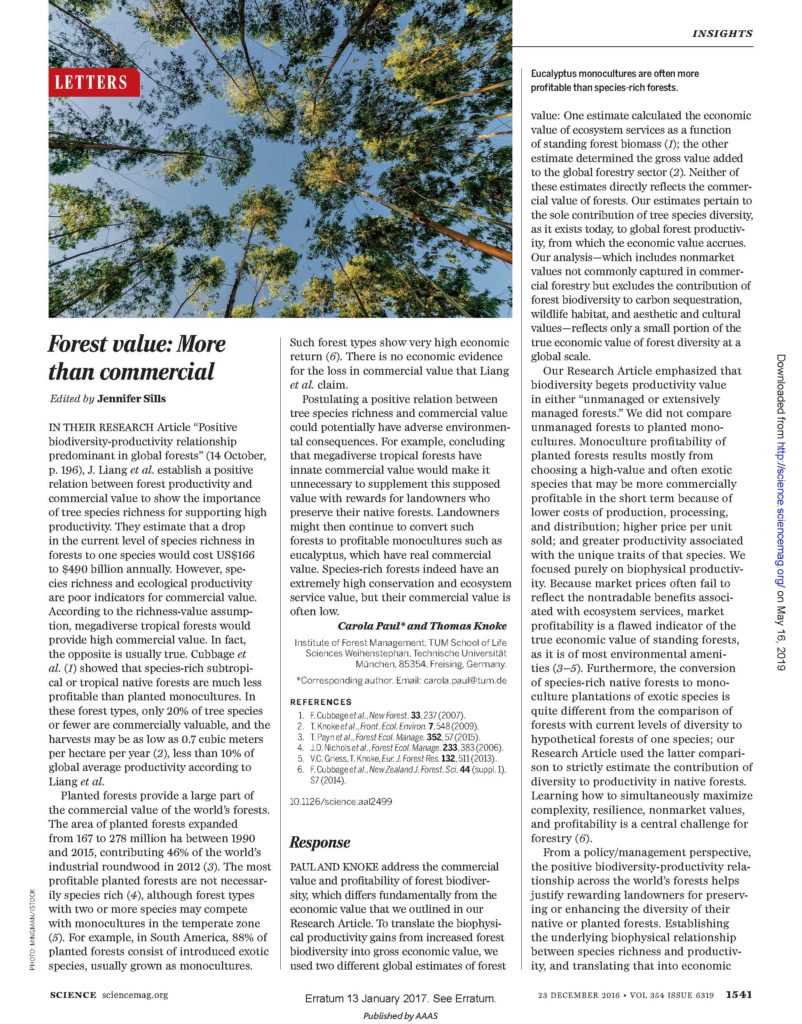Science#2016
Positive Biodiversity–Productivity Relationship Predominant in Global Forests

The biodiversity–productivity relationship (BPR) is foundational to our understanding of the global extinction crisis and its impacts on ecosystem functioning. Understanding BPR is critical for the accurate valuation and effective conservation of biodiversity. Using ground-sourced data from 777,126 permanent plots, spanning 44 countries and most terrestrial biomes, we reveal a globally consistent positive concave-down BPR, whereby a continued biodiversity loss would result in an accelerating decline in forest productivity worldwide. The value of biodiversity in maintaining commercial forest productivity alone—US$166–490 billion per year according to our estimation—is by itself over two to six times the total estimated cost that would be necessary for effective global conservation. This highlights the need for a worldwide re-assessment of biodiversity values, forest management strategies, and conservation priorities.
Comments and Discussion
Forest value: More than commercial
by Christopher B. Barrett, Mo Zhou, Peter B. Reich, Thomas W. Crowther, Jingjing Liang*


# Response to the three eLetters to Science:
- Jingjing Liang, Assistant Professor of Quantitative Forest Ecology,Purdue University
(21 November 2018)
RE: Responses to the three eLetters below
My sincere thanks to the three eLetters regarding our article entitled “Positive biodiversity-productivity relationship predominant in global forests,” and would welcome future questions, comments, criticisms, and research proposals from the authors of these eLetters!
Please find, below, my brief response to these eLetters. For future questions, please do not hesitate to contact me at alpenbering@gmail.com, or the GFBI Steering Committee at gfbinitiative@gmail.com.
- Generality of biodiversity-productivity relationships in global forests
Van de Perre et al. suggest that relationships between productivity and different components of taxonomic biodiversity, or between productivity and different dimensions biodiversity, are not necessarily positive, and that such relationships are in fact largely unknown for most clades of the tree of life.
Taxonomic diversity has been a focus of biodiversity research, and species richness has been widely used as a proxy for all aspects of taxonomic biodiversity (e.g. evenness, dominance, dispersion, diversity) as well as for other dimensions of biodiversity (e.g. genetic, phylogenetic, functional) (Willig and Presley 2013). However, the effects of different components/dimensions of biodiversity on ecosystem functioning are indeed largely unknown.
I thank Van de Perre et al. for bringing this to our attention! After decades of intensive research on the biodiversity-productivity relationship, much still remains to be explored in this topic. The Global Forest Biodiversity Initiative (GFBI) provides a platform to facilitate international research collaboration, and I look forward to working with the authors in future to help answer some of these very important questions. - Causal relationship between biodiversity and productivity, thank Man et al. for their suggestion that 1) the causality behind the biodiversity-productivity relationship (BPR) can only be examined through controlled experiments, and 2) the effect of tree species richness on productivity is overestimated by the models developed from observational data, based on 2a) a comparison with the biodiversity experiments with grassland ecosystems, and 2b) the lack of separation of biodiversity effects from those of environmental variables.
Regarding Point #1, I agree that controlled experiments is an effective and direct way to study causality, but I also submit to the notion that observations, especially those from a large-scale, can provide valid inference of causality. In fact, drawing inference of causality from observations is a basis for the data-driven science (view detailed description). It is technically very difficult, if at all possible, to conduct biodiversity experiments in every single forest type across the world, and biodiversity experiments cannot incorporate all possible species compositions and environmental factors in forests worldwide. To this end, GFB forest inventory data provide a good alternative and likely the only feasible way to study BPR at a global scale.
Regarding Point #2, firstly, our global BPR trend is not comparable to biodiversity experiments with grassland ecosystems. Our GFB data shows that forest communities across the world have a mean productivity of 7.57 m3ha-1yr-1 with a standard deviation of 14.52 m3ha-1yr-1. Trying to match this with local grassland experiments that typically features an above-ground biomass of approx.. 0.2kg/m2 (Tilman, et al. 2001) is like comparing apples to oranges. Secondly, we tried our best to account for potentially confounding environmental covariates in assessing likely causal effects of biodiversity on productivity. In Liang et al. 2016, we studied 15 potential biotic and abiotic covariates in developing the BPR model (Fig. 6).
I will demonstrate below that even at a much smaller ecoregion-level, the curvature and magnitude of the trendline and standard error bands are similar to the global trend as reported by Liang et al. 2016. For this demonstration, I selected the three grassland biomes (i.e. Montane Grasslands and Shrublands, Flooded Grasslands and Savannas, and Temperate Grasslands, Savannas and Shrublands).
The combined grassland biomes have a total of 23,133 plots. For simplicity, I ignored the spatial autocorrelation, and the result from a robust bootstrapping estimation (Efron and Tibshirani 1993) is quite consistent with the global trend of Liang et al. 2016. As shown in the graph, as the relative species richness declined from 100% to 1%, for the grassland biomes, forest productivity declined from on average 4.5 to 0.9 m3ha-1yr-1, an 80 percent decline.
Download graph & associated R script - RE: Biodiversity and forest productivity: How may tree species loss affect productivity?
Guo et al. claim that our study overestimated the negative impacts of species loss on forest ecosystem values and services. The reasons provided are 1) this estimate comes from inventory data-based species richness-productivity relationships that contain confounding effects by environmental factors such as precipitation and aridity, and 2) a quantification to combine results from 126 mixed species experiments in different world forest types yields an average of 15% productivity gain (Jactel, et al. 2018)
First of all, we did account for potentially confounding environmental covariates in assessing the effects of biodiversity on productivity. More specifically, we studied 15 potential biotic and abiotic covariates in developing the BPR model (Fig. 6). In the final model, we selected and used stand basal area (G), temperature seasonality (T3), annual precipitation (C1), precipitation of the warmest quarter (C3), potential evapotranspiration (PET), indexed annual aridity (IAA), and plot elevation (E) as control variables. Therefore, we have minimized the confounding effects by environmental factors such as precipitation and aridity.
Secondly, the cited reference (Jactel, et al. 2018) actually consists of a meta-analysis of 126 case studies established at 60 sites. Because of the limited spatial coverage and species compositions that are represented by these 60 sites, it is unlikely that the results can be comparable to our global estimates.
To investigate potential loss of productivity from species loss in a relatively smaller geographic unit, I demonstrate below that even at a much smaller ecoregion-level, the curvature and magnitude of BPR are similar to the global trend as reported by Liang et al. 2016. For this demonstration, I selected the three grassland biomes (i.e. Montane Grasslands and Shrublands, Flooded Grasslands and Savannas, and Temperate Grasslands, Savannas and Shrublands), The combined grassland biomes have a total of 23,133 plots. For simplicity, I ignored the spatial autocorrelation, and the result from a robust bootstrapping estimation (Efron and Tibshirani, 1993) is quite consistent with the global trend of Liang et al. 2016. As shown in the graph, as the relative species richness declined from 100% to 1%, for the grassland biomes, forest productivity declined from on average 4.5 to 0.9 m3ha-1yr-1, an 80 percent decline.
That being said, our reported BPR trend represents a ceteris paribus relationship, that is under the condition that other things remain the same. This is an educated guess under the current availability of data. It is still unknown how well this modelled trend can represent the actual productivity decline from species loss. To this end, more biodiversity experiments are needed and an assessment of the forest productivity change over temporal changes in tree species diversity would be useful.
Download graph & associated R script
References
- Efron, B. and Tibshirani, R.J. 1993 An introduction to the bootstrap. Chapman & Hall: New York, 436 p.
- Jactel, H., Gritti, E., Drössler, L., Forrester, D., Mason, W., Morin, X. et al. 2018 Positive biodiversity–productivity relationships in forests: climate matters. Biology letters, 14 (4), 20170747.
- Tilman, D., Reich, P.B., Knops, J., Wedin, D., Mielke, T. and Lehman, C. 2001 Diversity and productivity in a long-term grassland experiment. Science, 294 (5543), 843-845.
- Willig, M.R. and Presley, S.J. 2013 Latitudinal Gradients of Biodiversity. In Encyclopedia of Biodiversity, 2nd edition, Academic Press Waltham, Massachusetts, pp. 612-626. Competing Interests: None declared.
# Response to Dormann et al. (2019):
bioRxiv 524363; doi: https://doi.org/10.1101/524363
Neither global nor consistent: a technical comment on the tree diversity-productivity analysis of Liang et al. (2016) by Carsten F Dormann, Helge Schneider, Jonas Gorges. bioRxiv 524363; doi: https://doi.org/10.1101/524363
- Jingjing Liang, Assistant Professor of Quantitative Forest Ecology,Purdue University
- GFBI Steering Committee
(21 November 2018)
Click the link below to download our full response in PDF format: